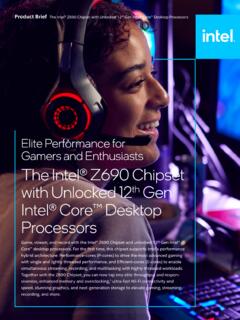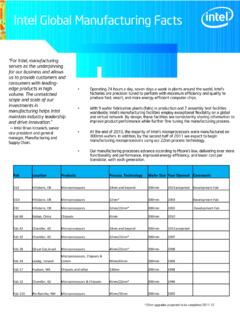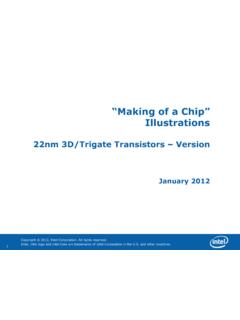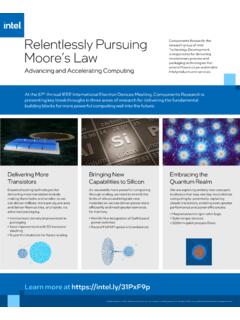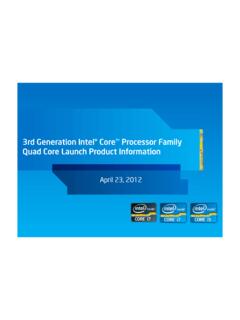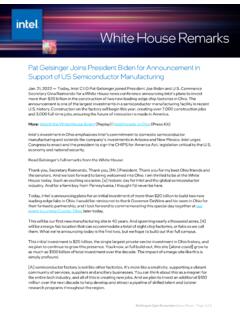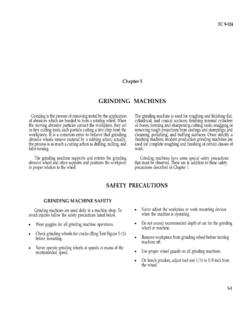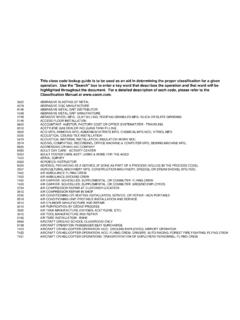Transcription of From Sand to Silicon - Intel
1 Copyright 2011, Intel Corporation. All rights reserved. Intel , Intel logo and Intel Core are trademarks of Intel Corporation in the and other countries. 1 From Sand to Silicon Making of a Chip Illustrations32nm High-K/ metal Gate VersionIncluding 2nd Generation Intel Core processor familyApril 2011 Copyright 2011, Intel Corporation. All rights reserved. Intel , Intel logo and Intel Core are trademarks of Intel Corporation in the and other countries. 2 The illustrations on the following foils are low resolution images that visually support the explanations of the individual publishing purposes there are high resolution JPEG files posted to the Intel high resolution images are available as well.
2 Please request them from 2011, Intel Corporation. All rights reserved. Intel , Intel logo and Intel Core are trademarks of Intel Corporation in the and other countries. 3 Sand / IngotSandWith about 25% (mass) Silicon is after Oxygen the second most frequent chemical element in the earth s crust. Sand especially Quartz -has high percentages of Silicon in the form of Silicon dioxide (SiO2) and is the base ingredient for semiconductor Silicon scale: wafer level (~300mm/ 12 inch) Silicon is purified in multiple steps to finally reach semiconductor manufacturing quality which is called Electronic Grade Silicon . Electronic Grade Silicon may only have one alien atom every one billion Silicon atoms.
3 In this picture you can see how one big crystal is grown from the purified Silicon melt. The resulting mono crystal is called an Silicon Ingot scale: wafer level (~300mm/ 12 inch)An ingot has been produced from Electronic Grade Silicon . One ingot weights about 100 kilograms (=220 pounds) and has a Silicon purity of 2011, Intel Corporation. All rights reserved. Intel , Intel logo and Intel Core are trademarks of Intel Corporation in the and other countries. 4 Ingot / WaferIngot Slicing scale: wafer level (~300mm / 12 inch)The Ingot is cut into individual Silicon discs called wafers. The thickness of a wafer is about scale: wafer level (~300mm/ 12 inch)The wafers are polished until they have flawless, mirror-smooth surfaces.
4 Intel buys those manufacturing ready wafers from third party companies. Intel s highly advanced 32nm High-K/ metal Gate process uses wafers with a diameter of 300 millimeter (~12 inches). When Intel first began making chips, the company printed circuits on 2-inch (50mm) wafers. Now the company uses 300mm wafers, resulting in decreased costs per chip. Copyright 2011, Intel Corporation. All rights reserved. Intel , Intel logo and Intel Core are trademarks of Intel Corporation in the and other countries. 5 Fabrication of chips on a wafer consists of hundreds of precisely controlled steps which result in a series of patterned layers of various materials one on top of another. What follows is a sample of the most important steps in this complex process.
5 Copyright 2011, Intel Corporation. All rights reserved. Intel , Intel logo and Intel Core are trademarks of Intel Corporation in the and other countries. 6 Ion ImplantationApplying Photo Resist scale: wafer level (~300mm / 12 inch)Fabrication of chips on a wafer consists of hundreds of precisely controlled steps which result in a series of patterned layers of various materials one on top of another. What follows is a sample of the most important steps in this complex process. In this image there s photo resist (blue color) applied, exposed and exposed photo resist is being washed off before the next step (more details later). The remaining photo resist (blue shine on wafer) will protect material that should not get ions Implantation scale: wafer level (~300mm / 12 inch)The wafer is patterned using photolithography (details of how this is done will be described later).
6 The wafer is bombarded with a beam of ions (positively or negatively charged atoms) which embed themselves beneath the surface of the wafer to alter the conductive properties of the Silicon in selected locations. The green regions in the image to the right have these implanted alien Photo Resist scale: wafer level (~300mm / 12 inch)After the ion implantation the photo resist will be removed and the material that should have been doped (green) has alien atoms implanted now (notice slight variations in color)Copyright 2011, Intel Corporation. All rights reserved. Intel , Intel logo and Intel Core are trademarks of Intel Corporation in the and other countries. 7 High-k Dielectric DepositionApplying High-k Dielectric scale: wafer level (~300mm / 12 inch)Instead of a traditional insulator between a transistor s gate and its channel, Intel applies multiple layers of High-K dielectric material to the surface of the wafer.
7 This material is applied one atomic layer at a time (yellow in the image). This reduces electrical leakage and enables more energy-efficient High-k dielectric scale: wafer level (~300mm / 12 inch)There are multiple layers of individual molecule layers being applied to the surface of the wafer. The two yellow layers shown here represent two of these Dielectric scale: transistor level (~50-200nm)This step shows how the High-k insulator has been applied to the whole wafer. The High-k material is thicker than the traditional Silicon -Dioxide layer while it has the same capacitive properties to maximize performance. Due to the increased thickness less current leaks through this innovative 2011, Intel Corporation.
8 All rights reserved. Intel , Intel logo and Intel Core are trademarks of Intel Corporation in the and other countries. 8 Photo LithographyApplying Photo Resist scale: wafer level (~300mm / 12 inch)The liquid (dark color here) that s poured onto the wafer while it spins is a photo resist finish similar as the one known from film photography. The wafer spins during this step to allow very thin and even application of this photo resist scale: wafer level (~300mm / 12 inch)The photo resist finish is exposed to ultra violet (UV) light. The chemical reaction triggered by that process step is similar to what happens to film material in a film camera the moment you press the shutter button. The photo resist finish that s exposed to UV light will become soluble.
9 The exposure is done using masks that act like stencils in this process step. When used with UV light, masks create the various circuit patterns on each layer of the microprocessor. A lens (middle) reduces the mask s image. So what gets printed on the wafer is typically four times smaller linearly than the mask s scale: transistor level (~50-200nm)Although usually hundreds of microprocessors are built on a single wafer, this picture story will only focus on a small piece of a microprocessor from now on on a transistor or parts thereof. A transistor acts as a switch, controlling the flow of electrical current in a computer chip. Intel researchers have developed transistors so small that about 30 million of them could fit on the head of a 2011, Intel Corporation.
10 All rights reserved. Intel , Intel logo and Intel Core are trademarks of Intel Corporation in the and other countries. 9 EtchingWashing off of Photo Resist scale: transistor level (~50-200nm)The gooey photo resist is completely dissolved by a solvent. This reveals a pattern of photo resist made by the mask (dark rectangle here). Etching scale: transistor level (~50-200nm)The photo resist is protecting the high-k dielectric that should not be etched away. Revealed material will be etched away with Photo Resist scale: transistor level (~50-200nm)After the etching the photo resist is removed and the desired shape becomes 2011, Intel Corporation. All rights reserved. Intel , Intel logo and Intel Core are trademarks of Intel Corporation in the and other countries.
